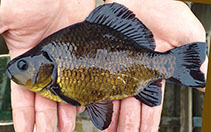Armenia country information
Common names:
[No common name]
Occurrence: native
Salinity: freshwater
Abundance: | Ref:
Importance: | Ref:
Aquaculture: | Ref:
Regulations: | Ref:
Uses: no uses
Comments:
National Checklist:
Country Information: https://www.cia.gov/library/publications/resources/the-world-factbook/geos/am.html
National Fisheries Authority:
Occurrences: Occurrences Point map
Main Ref: Blanc, M., J.-L. Gaudet, P. Banarescu and J.-C. Hureau, 1971
National Database:
Occurrence: native
Salinity: freshwater
Abundance: | Ref:
Importance: | Ref:
Aquaculture: | Ref:
Regulations: | Ref:
Uses: no uses
Comments:
National Checklist:
Country Information: https://www.cia.gov/library/publications/resources/the-world-factbook/geos/am.html
National Fisheries Authority:
Occurrences: Occurrences Point map
Main Ref: Blanc, M., J.-L. Gaudet, P. Banarescu and J.-C. Hureau, 1971
National Database:
Common names from other countries
分類 / Names 共通名の | 類義語 | Catalog of Fishes(部類, 種) | ITIS | CoL | WoRMS | Cloffa
> Cypriniformes (Carps) > Cyprinidae (Minnows or carps) > Cyprininae
Etymology: Carassius: Latinization of , karass, karausche, European crucian carp (Ref. 45335).
More on author: Linnaeus.
Etymology: Carassius: Latinization of , karass, karausche, European crucian carp (Ref. 45335).
More on author: Linnaeus.
Environment: milieu / climate zone / depth range / distribution range 生態学
; 新鮮な水; 汽水性の 底生の; potamodromous (Ref. 51243); 深さの範囲 5 - ? m (Ref. 2163). Temperate; 2°C - 22°C (Ref. 1672); 69°N - 35°N, 10°W - 169°E
分布 国々 | 国連食糧農業機関の区域 | エコシステム | 事件 | Point map | 導入 | Faunafri
Eurasia: North, Baltic, White, Barents, Black and Caspian Sea basins; Aegean Sea basin only in Maritza drainage; eastward to Kolyma drainage (Siberia); westward to Rhine and eastern drainages of England. Absent from North Sea basin in Sweden and Norway. In Baltic basin north to about 66°N. Widely introduced to Italy, England and France but possibly often confused with Carassius gibelio (Ref. 59043). At least one country reports adverse ecological impact after introduction.
サイズ / 重さ / 年齢
Maturity: Lm ? range ? - ? cm
Max length : 64.0 cm TL オス/雌雄の選別がない; (Ref. 6114); common length : 15.0 cm TL オス/雌雄の選別がない; (Ref. 556); 最大公表体重: 3.0 kg (Ref. 556); 最大記録サイズ: 10 年 (Ref. 59043)
Max length : 64.0 cm TL オス/雌雄の選別がない; (Ref. 6114); common length : 15.0 cm TL オス/雌雄の選別がない; (Ref. 556); 最大公表体重: 3.0 kg (Ref. 556); 最大記録サイズ: 10 年 (Ref. 59043)
簡単な記述 検索表 | 形態学 | 形態計測学
背面の脊椎 (合計) : 3 - 4; 背鰭 (合計) : 13 - 22; 肛門の骨: 2 - 3; 臀鰭: 5 - 7; 脊つい: 32. Diagnosed from its congeners in Europe by having the following characters: body golden-green shining color; last simple anal and dorsal rays weakly serrated; 23-33 gill rakers; lateral line with 31-36 scales; free edge of dorsal convex; anal fin usually with 6½ branched rays; and peritoneum white (Ref. 59043). Caudal fin with 18-20 rays (Ref. 2196). No barbels. The third dorsal and anal-fin rays are strong and serrated posteriorly.
Adults occur in shallow ponds, lakes rich in vegetation and slow moving rivers. They burrow in mud in the dry season or during winter (Ref. 2163). Usually restricted to densely vegetated backwaters and oxbows of lowland rivers. Can survive at high temperatures and at very low oxygen concentrations during summer and under ice cover (Ref. 59043). Tolerates cold, organic pollutants, and low oxygen levels in the water (Ref. 30578). Feeds all day but mainly at night on plankton, benthic invertebrates, plant materials and detritus. Usually does not occur in waters with rich ichthyofauna and abundant predatory species, but very abundant in the absence of other fish species. Spawns in dense submerged vegetation (Ref. 59043). Marketed fresh and frozen; eaten fried, broiled and baked (Ref. 9988). Live up to about 10 years. There is a gradual but continuing extirpation in many water bodies, especially in Danube drainage and central Europe, possibly to due competition with introduced Carassius gibelio in non-optimal habitats (Ref. 59043).
Life cycle and mating behavior 成熟 | 繁殖 | 放精 | 卵 | 生産力 | 幼生
Females spawn multiple times during the spawning period (Ref. 88808). Reproduction in May-June in shallow water with dense vegetation, eggs 130000-250000/female adhere to plants, hatch after 4-8 days (Ref. 2163). Individual female spawn with several males. Males follow ripe females, often with much splashing. Eggs are sticky and are attached to water plants (Ref. 59043).
主な参考文献
Upload your references | 参考文献 | コーディネーター | 協力者
Kottelat, M. and J. Freyhof, 2007. Handbook of European freshwater fishes. Publications Kottelat, Cornol and Freyhof, Berlin. 646 pp. (Ref. 59043)
Human uses
水産業: 高い商業の; 水産養殖: 商業; ゲームフィッシュ: はい; 水族館・水槽: 商業; 餌: occasionally
より多くの情報
Population dynamics
成長のパラメーター
Max. ages / sizes
Length-weight rel.
Length-length rel.
体長組成
Mass conversion
補充
豊度
成長のパラメーター
Max. ages / sizes
Length-weight rel.
Length-length rel.
体長組成
Mass conversion
補充
豊度
Physiology
Body composition
Nutrients
酸素消費
水泳形態
泳ぐ速さ
Visual pigments
Fish sound
Diseases & Parasites
Toxicity (LC50s)
Body composition
Nutrients
酸素消費
水泳形態
泳ぐ速さ
Visual pigments
Fish sound
Diseases & Parasites
Toxicity (LC50s)
用具
E-book | 野外観察図鑑 | 検索表 | Length-frequency wizard | 生活史の基盤ツール | 目的のマップ | Classification Tree
| Catch-MSY |
特記事項
XMLをダウンロードして下さい
インターネットの情報源
Alien/Invasive Species database | Aquatic Commons | BHL | Cloffa | BOLDSystems | Websites from users | Check FishWatcher | CISTI | Catalog of Fishes(部類, 種) | DiscoverLife | ECOTOX | Faunafri | Fishtrace | GenBank(ゲノム, ヌクレオチド) | GloBI | GOBASE | | Google Books | Google Scholar | Google | IGFA World Record | MitoFish | 国のデーターベース | Otolith Atlas of Taiwan Fishes | 公共の水族館 | PubMed | Reef Life Survey | Scirus | SeaLifeBase | 生命の木 | Wikipedia(行く, 検索する) | World Records Freshwater Fishing | 動物に関する記録
Estimates based on models
Phylogenetic diversity index (Ref. 82804): PD50 = 0.5156 [Uniqueness, from 0.5 = low to 2.0 = high].
Bayesian length-weight: a=0.01349 (0.01051 - 0.01732), b=3.04 (3.00 - 3.08), in cm Total Length, based on LWR estimates for this species (Ref. 93245).
栄養段階 (Ref. 69278): 3.1 ±0.24 se; based on food items.
回復力 (Ref. 120179): 手段, 1.4年~4.4年の倍増期間の最小個体群 (tm=2).
Fishing Vulnerability (Ref. 59153): Moderate vulnerability (39 of 100).





